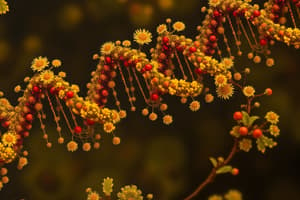Podcast
Questions and Answers
What is the main purpose of gene regulation in organisms?
What is the main purpose of gene regulation in organisms?
- To control gene expression for production of proteins when needed (correct)
- To increase the mutation rate
- To eliminate unnecessary genes
- To increase energy consumption
Constitutive genes are those that are expressed at variable levels depending on environmental conditions.
Constitutive genes are those that are expressed at variable levels depending on environmental conditions.
False (B)
Name one way that gene regulation benefits organisms.
Name one way that gene regulation benefits organisms.
It conserves energy by producing only what is needed.
Gene regulation in eukaryotes can involve changes in __________ structure and DNA methylation.
Gene regulation in eukaryotes can involve changes in __________ structure and DNA methylation.
Match the following stages of development to their corresponding oxygen binding abilities:
Match the following stages of development to their corresponding oxygen binding abilities:
What is required for RNA polymerase II to initiate transcription?
What is required for RNA polymerase II to initiate transcription?
Activators and repressors bind to the same sequences in the DNA.
Activators and repressors bind to the same sequences in the DNA.
What role does TFIID play in the transcription process?
What role does TFIID play in the transcription process?
Combinatorial control in eukaryotic genes is mainly regulated by the combination of many ________.
Combinatorial control in eukaryotic genes is mainly regulated by the combination of many ________.
Match the following elements with their roles in transcription regulation:
Match the following elements with their roles in transcription regulation:
Which general transcription factor is a target for both activators and repressors?
Which general transcription factor is a target for both activators and repressors?
Most eukaryotic genes are regulated by a single factor.
Most eukaryotic genes are regulated by a single factor.
What is the primary role of nucleosome-free regions (NFR) in eukaryotic genes?
What is the primary role of nucleosome-free regions (NFR) in eukaryotic genes?
Nucleosomes become more compact during gene transcription.
Nucleosomes become more compact during gene transcription.
What are the two main ways chromatin structure can be altered to enhance transcription?
What are the two main ways chromatin structure can be altered to enhance transcription?
The formation of _______ heterochromatin can silence genes in a tissue-specific manner.
The formation of _______ heterochromatin can silence genes in a tissue-specific manner.
Match the following terms with their descriptions:
Match the following terms with their descriptions:
Which enzyme is primarily responsible for synthesizing RNA during transcription?
Which enzyme is primarily responsible for synthesizing RNA during transcription?
The closed conformation of chromatin is easily accessible for transcription.
The closed conformation of chromatin is easily accessible for transcription.
Why do eukaryotes require chromatin remodeling during gene expression?
Why do eukaryotes require chromatin remodeling during gene expression?
During transcription elongation, nucleosomes ______ to allow RNA polymerase to move along the DNA.
During transcription elongation, nucleosomes ______ to allow RNA polymerase to move along the DNA.
What effect does DNA methylation typically have on gene transcription?
What effect does DNA methylation typically have on gene transcription?
What is a function of DNA methylation in eukaryotes?
What is a function of DNA methylation in eukaryotes?
Alternative splicing allows a single gene to code for multiple proteins.
Alternative splicing allows a single gene to code for multiple proteins.
What protein regulates iron absorption in mammals by controlling the mRNA that encodes ferritin?
What protein regulates iron absorption in mammals by controlling the mRNA that encodes ferritin?
The process of ______ enhances protein diversity by allowing different combinations of exons to be included in mRNA.
The process of ______ enhances protein diversity by allowing different combinations of exons to be included in mRNA.
What is the role of RNA-binding proteins in eukaryotic cells?
What is the role of RNA-binding proteins in eukaryotic cells?
High levels of iron are beneficial for cells and enhance protein synthesis.
High levels of iron are beneficial for cells and enhance protein synthesis.
Name one outcome of gene transcription regulation in prokaryotes.
Name one outcome of gene transcription regulation in prokaryotes.
The regulation of iron absorption is an example of how ______ can control protein translation.
The regulation of iron absorption is an example of how ______ can control protein translation.
Flashcards
Gene Regulation
Gene Regulation
The process by which cells control the expression of their genes.
Constitutive Genes
Constitutive Genes
Genes with relatively constant levels of expression needed for essential processes.
Eukaryotic Gene Regulation
Eukaryotic Gene Regulation
Allows a multicellular organism to precisely control gene expression throughout development.
Gene Expression
Gene Expression
Signup and view all the flashcards
Protein Regulation of Genes
Protein Regulation of Genes
Signup and view all the flashcards
General Transcription Factors (GTFs)
General Transcription Factors (GTFs)
Signup and view all the flashcards
Activators
Activators
Signup and view all the flashcards
Repressors
Repressors
Signup and view all the flashcards
Combinatorial Control
Combinatorial Control
Signup and view all the flashcards
TFIID
TFIID
Signup and view all the flashcards
Chromatin Structure
Chromatin Structure
Signup and view all the flashcards
DNA Methylation
DNA Methylation
Signup and view all the flashcards
Nucleosome-Free Regions (NFRs)
Nucleosome-Free Regions (NFRs)
Signup and view all the flashcards
Chromatin Remodeling Complexes
Chromatin Remodeling Complexes
Signup and view all the flashcards
How do NFRs facilitate transcription?
How do NFRs facilitate transcription?
Signup and view all the flashcards
Histone Tail Modifications
Histone Tail Modifications
Signup and view all the flashcards
Transcription Elongation & Nucleosomes
Transcription Elongation & Nucleosomes
Signup and view all the flashcards
Facultative Heterochromatin
Facultative Heterochromatin
Signup and view all the flashcards
How does facultative heterochromatin silence genes?
How does facultative heterochromatin silence genes?
Signup and view all the flashcards
Tissue-Specific Gene Silencing
Tissue-Specific Gene Silencing
Signup and view all the flashcards
Alternative Splicing
Alternative Splicing
Signup and view all the flashcards
Protein Diversity
Protein Diversity
Signup and view all the flashcards
Iron Regulation in Mammals
Iron Regulation in Mammals
Signup and view all the flashcards
Ferritin
Ferritin
Signup and view all the flashcards
Iron Regulatory Protein (IRP)
Iron Regulatory Protein (IRP)
Signup and view all the flashcards
Transferrin Receptor
Transferrin Receptor
Signup and view all the flashcards
How does alternative splicing increase protein diversity?
How does alternative splicing increase protein diversity?
Signup and view all the flashcards
What is the function of ferritin?
What is the function of ferritin?
Signup and view all the flashcards
Explain the role of IRP in iron regulation.
Explain the role of IRP in iron regulation.
Signup and view all the flashcards
Study Notes
Gene Regulation Overview
- Gene regulation is the ability of cells to control the expression of their genes.
- Most genes are regulated to ensure proteins are produced at the correct time and in the correct amount.
- Regulation conserves energy by producing only what is needed.
- Some genes have relatively constant levels of expression; these are constitutive genes. They frequently encode proteins constantly required, like enzymes for carbohydrate metabolism.
- Many proteins regulate gene expression by binding to DNA.
Eukaryotic Gene Regulation
- Enables multicellular organisms to proceed through developmental stages.
- Certain genes are expressed at particular stages.
- Example: Hemoglobin protein changes throughout development (embryo, fetus, adult). The specific gene expression of different forms of hemoglobin (α- and β-globin sequences) changes with developmental stage.
Gene Regulation Practice Questions
- How do genomes differ among different cell types (e.g. skeletal muscle, neuron, skin cell)?
- How do proteomes differ among different cell types?
Eukaryotic Cell Differentiation
- Cell differentiation is the process by which cells become specialized into particular types.
- Different cells have different specialized functions.
Gene Regulation in Eukaryotes: Points in the Process
- Transcriptional regulation
- RNA modification
- Alternative Splicing
- Translation regulation
Eukaryotic Protein-Encoding Genes
- Include a core promoter and regulatory elements.
- The core promoter contains the TATA box and the transcription start site.
- The core promoter alone results in a low level of basal transcription.
Transcription Factors
- Bind to gene regulatory elements.
- Two types: enhancers and silencers.
RNA Polymerase II
- Transcribes genes that encode proteins.
- Requires five different general transcription factors (GTFs) to initiate transcription.
- GTFs ensure RNA polymerase starts in the right place and facing the correct direction.
Activators and Repressors
- Activators bind to enhancer sequences.
- Repressors bind to silencer sequences.
- They commonly regulate transcription by affecting the function of GTFs.
- TFIID binds the TATA box and is a common target for activators and repressors.
- TFIID plays a critical role in ensuring RNA polymerase is correctly positioned.
Combinatorial Control in Eukaryotes
- Most eukaryotic genes are under combinatorial control.
- This means expression is regulated by the combination of many factors.
- Activators and repressors, and environmental signals influence the expression levels of a gene.
DNA Methylation
- DNA methylation can inhibit gene transcription.
- This adds a methyl group to a DNA base in the gene region.
- The added methyl group can prevent transcription initiation by binding proteins to block the regulatory regions.
- The amount of methylation can be influenced by environmental factors.
Chromatin Structure
-
Some genes are buried in tight chromatin.
-
Tight conformation blocks RNA polymerase from accessing the DNA, needed to regulate the production of proteins.
-
A region in a closed conformation is difficult or impossible to transcribe; transcription requires changes in chromatin structure..
-
In an open conformation, the region is accessible to GTFs and RNA polymerase II and can therefore be transcribed.
-
Changes in chromatin structure is controlled by chromatin remodeling.
-
Changes include moving nucleosomes around.
-
Replacing histone components.
-
Two ways to modify chromatin structure:
-
Modify histone tails
-
Directly methylate cytosines
Nucleosome-Free Regions (NFR)
- Exist at the beginning and end of genes.
- Allow for access of RNA polymerase, a necessary step in transcriptional regulation.
Bacteria: Lac Operon
-
Operon: a cluster of genes under the control of a single promoter. Example: lac operon in E. coli.
-
The operon contains genes for lactose metabolism.
-
lac operon is regulated by negative and positive control.
- Negative Control: A repressor protein binds to the operator region preventing RNA polymerase from binding and transcribing the operon.
- Positive Control: An activator protein, CAP (catabolite activator protein), binds to a CAP site.
-
Additional Factors: Cyclic AMP (cAMP) is the small, effector molecule that controls the activity of CAP. cAMP levels are impacted by glucose levels:
-
High glucose, low cAMP
-
Low glucose, high cAMP
Regulatory Transcription Factors
- Proteins that bind to regulatory sequences in DNA and control gene expression
- Includes activators and repressors (negative and positive control in bacteria).
RNA Splicing
- Alternative splicing allows an organism to use the same gene to make different proteins at different stages of development.
- RNA binding proteins regulate translation of specific mRNAs.
- Example: iron regulation in mammals. The mRNA for ferritin, a protein that stores iron, is controlled by an Iron regulatory protein (IRP). The presence of iron in the cell stops the protein, and ferritin expression is turned on.
Studying That Suits You
Use AI to generate personalized quizzes and flashcards to suit your learning preferences.




